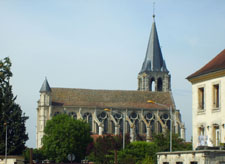Brie-Comte-Robert (Seine-et-Marne, France) - Saint-Étienne
- Disclaimer
The dating found here is based on the work of John James, and is meant on this site to serve as a starting point. James' dating is derived from a system that uses his interpretation of the development of capitals over time as the basis for chronology, among other factors. His goal is to refine the dating to within years rather than decades. I have not fully embraced James' methodology, and will be developing this page from its current state to one which is admittedly more conservative. The relative expenditure values found in the Timeline are also based on James' work, and I believe these to be reasonably reliable. They are intended only to give a sense of the amount of work involved in each decade.
I have added the idea of the "project" as a way of separating work in buildings. In my mind, a "project" is a discrete section of work in a building that resulted from the one-time acquisition of funding. "Projects" are generally separated by at least a decade where no work was being done. It is my view that it would have been unwise to start a "project" that could not be finished and protected from the elements, and as such a "project" usually involved a wing or multiple wings of a building, from floor to roof. Rural churches, which could only secure small amounts of funding at irregular intervals, often were the result of many small projects, while the great churches, which benefitted from relatively consistent funding, may have involved only a few large projects.
I have added the idea of the "project" as a way of separating work in buildings. In my mind, a "project" is a discrete section of work in a building that resulted from the one-time acquisition of funding. "Projects" are generally separated by at least a decade where no work was being done. It is my view that it would have been unwise to start a "project" that could not be finished and protected from the elements, and as such a "project" usually involved a wing or multiple wings of a building, from floor to roof. Rural churches, which could only secure small amounts of funding at irregular intervals, often were the result of many small projects, while the great churches, which benefitted from relatively consistent funding, may have involved only a few large projects.
- Timeline with Relative Expenditure (if available, in building units)
 |
 |
 |
 |
 |
 |
- Project A - 1190s - Phase 1 - choir (b) 1-4
Choir lower walls and bases1-4, with base for tower in short campaigns.
- Project A - 1200s - Phase 2 - choir (a) 1-4
Choir arcade 1-4 with drums, aisle vaults to gallery floor
- Project A - 1210s - Phase 3 - EN1(g)
While rest of choir remained under a roof the gallery level under the tower
- Project A - 1210s - Phase 4 - tower I
Tower I
- Project A - 1220s - Phase 5 - nave (a) 5-9
Nave arcade and walls 4-9, and west portal, to gallery floor
- Project A - 1230s - Phase 6 - church (t)
Church triforium with plate tracery, and glazed in the east wall.
- Project A - 1230s - Phase 7 - tower III
Tower III
- Project A - 1240s - Phase 8 - church (c)
Church clerestory with tracery windows and 7-part oculi, east rose window and high vaults with large projecting devil and angel busts.
